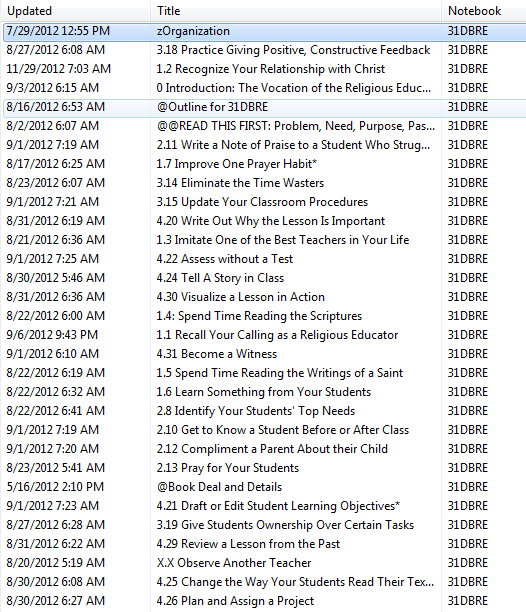How do you eat an elephant? The answer is relatively the same for writing a book.
How do authors write books? One word at a time.
But where do you get started?
I suppose all writers and artists have to figure this out on their own. I must have blocked it out of my memory in the last year or so.
During my Friday weekly review today, I was trying to sort through some old notes in Evernote when I came across my writing to-do list for my first book dating back in July 2012. I honestly can’t remember how much I referenced this note while actually writing the book and I didn’t even create it until well after I had brainstormed what I would write for the majority of the chapters/days of my 31-day book.
It got me thinking. . . How in the heck did I get this book written?
How Authors Write Books: Not from A to Z
Maybe I’ll go into more detail about how I use Evernote to write (now two) books someday. It was an incredible tool. I will say, that taking a look at my book’s “notebook” says a lot about how I was able to write the book. You can see from this screenshot, sorted by the first note I created in November 2011 and into 2012, that I didn’t work in a linear fashion. It shows the order I worked on the book had nothing to do with the order of the chapters:
The first number is the section (1-4) and the second number is the day/chapter (1-31).
(Funny, this screenshot also shows what time of day I do my writing: 4:45 a.m to 6:30 a.m.! I wake up early.)
I used a non-liner process to write the book. It was a 31-days book, but I definitely didn’t write in chronological order. In fact, the four parts of the book didn’t present themselves until I was probably half-way through the writing, probably about the time I wrote day one and then thirty-one.
Here was the key to getting this massive project done: I started with the days that came the easiest to write, then got to the harder ones and the ones that needed more research.
Here is what worked for me:
- Write what comes easiest, first.
- Build momentum.
- Tackle the hard stuff.
- Fear the deadline.
Writing the Introduction
Thinking back, I remember now that the Introduction was the hardest thing to write. I could knock-out the bulk of one of the thirty-one days within the 1-2 hours of writing I did each morning, but I put that Intro off until the end. In fact, I remember it taking me multiple days and some painstaking writing through the parts where I had to say what this book really is. If you look closely at the screenshot above, you will see that I started the into early, but put it off until the end.
I started with the easy stuff (how to use this book) and leaned on some quotes that got me through the writing. I made a number of hardcopy revisions based heavily on my re-reading of it and my wife’s first glance.
The Home Stretch: My Writing To Do List
Here is a copy of the note from Evernote. I found this morning. It shows the final steps I needed to take to get the book done. It was a lot of returning to what I had written and adding in the TK research and quotes I left out initially.
I needed this to do list in the home stretch. I need a step-by-step process to follow at the end, after the non-linear creative work was done, to meet that deadline and hand in the book.
Oh, the memories:
TRT: 31DBRE (Writing)
- Write each chapter
- 8
- 16 (R&D Leadership)
- 17
- 18
- 19 (R&D Leadership)
- 31dbre: develop strengths, give opportunities to learn the way they want, ownership ?
- 20
- 21
- 22
- 23
- 24
- 25
- 26
- 27
- 28
- 29
- 30
- 31
- Introduction
- Add Scripture passages to each day (1 day left)
- Edit each chapter (Day 9. . .)
- Check Going Deeper for each day
- Rewrite introduction
- 31dbre: read and research: http://www.thehighcalling.org/servant-leadership-christian-leadership-work
- Assemble into a word doc
- Proofread
- Give to Jen and others to read
- Update
- Proofread
- Turn in Manuscript to Mike
- Edit manuscript changes from Mike (Chapter 10)




